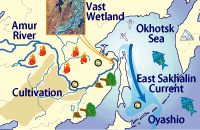

Achievements
| Three major achievements have been made since the Interim Evaluation (FR) on March 1, 2007. | ||
| 1. |
Material linkage from the Amur River basin to the Oyashio region via the Sea of Okhotsk was finally validated by 1) observations of the spatiotemporal distribution of dissolved iron in various parts of the Amur River basin, 2) monthly monitoring of dissolved iron concentrations and discharges at Khabarovsk and Bogorodskoe, 3) observations of the temporal distributions of dissolved iron in the lower reach, mouth, and estuarial area of the Amur River, 4) measurements of dissolved iron in the Sea of Okhotsk and Oyashio region, and 5) measurements of the atmospheric iron input to the Oyashio region (Fig. 1). It was found that approximately 40% of the dissolved iron necessary to support phytoplankton production in the Oyashio region was transported through the GFBF system. The remaining 60% was microbially recycled iron originally provided by both intermediate water and atmospheric input. |
|
| 2. | The Amur–Okhotsk Project identified the importance of the Amur River to the marine ecosystem in the Sea of Okhotsk and Oyashio region at a Japan–Russia meeting during the G8 Summit held at Toya Lake, Hokkaido, in July 2008. The leaders of both countries agreed to begin a joint ecological research program in which the Amur–Okhotsk dissolved iron transport system was stressed. This might be the first example of a Research Institute for Humanity and Nature (RIHN) project contributing to international policy making. |
|
| 3. | The importance of the conservation of the GFBF was referred to in a policy-making paper published by the Economic Research Institute for Northeast Asia and submitted to the Ministry of Foreign Affairs of Japan. |
|